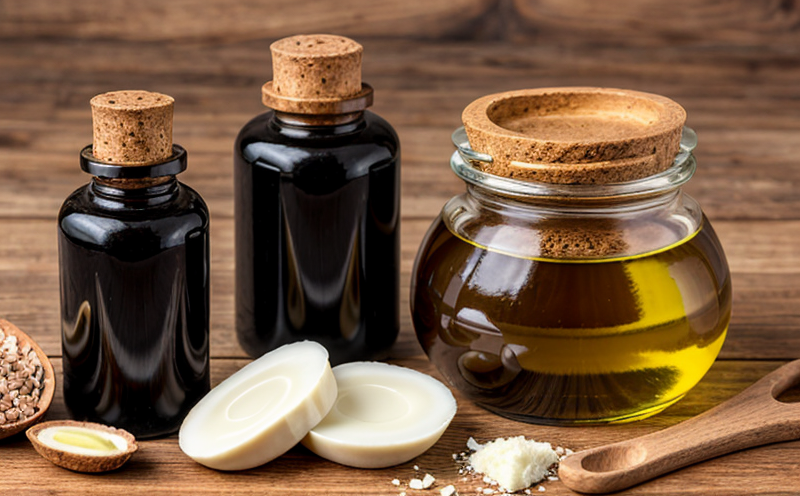AOAC 2009.06 Pesticide Residue Testing in Edible Oils
The AOAC International Method 2009.06 is a widely recognized and authoritative procedure for detecting pesticide residues in edible oils, including vegetable oils like soybean, canola, corn, and sunflower oil. This method ensures the safety of food products by identifying potentially harmful levels of pesticides that may have been applied during cultivation or processing.
The testing process involves several critical steps to ensure accuracy and reliability. The specimen preparation is crucial; it typically includes the extraction of the pesticide residues using a solvent followed by the cleanup step to remove any interfering substances. Once purified, the sample undergoes analysis via gas chromatography coupled with mass spectrometry (GC-MS), which allows for highly precise quantification.
The AOAC 2009.06 method is designed to comply with international standards such as ISO and ASTM, ensuring consistency across different laboratories worldwide. Compliance is essential in the food industry to maintain product integrity and consumer trust. This method has been validated by numerous research institutions and is used globally by quality managers, compliance officers, R&D engineers, and procurement teams.
The significance of this test cannot be overstated. Pesticide residues can pose serious health risks if present above safe limits. The AOAC 2009.06 method helps prevent such risks by providing accurate results that support regulatory requirements and consumer safety standards. For instance, the European Union's Maximum Residue Levels (MRLs) for pesticides in food products are strictly enforced to protect public health.
The testing process is not only about detecting residues but also ensuring they do not exceed acceptable limits set forth by regulatory bodies. This method supports several key objectives, including:
- Ensuring compliance with international and national standards
- Maintaining product quality and safety for consumers
- Supporting the integrity of supply chains from farm to fork
- Meeting regulatory requirements set by authorities like FDA, EU, and WHO
The AOAC International Method 2009.06 is a comprehensive approach that includes detailed protocols for sample preparation, extraction techniques, and analytical methods. These steps ensure the reliability of the test results and help laboratories maintain high standards of accuracy.
For quality managers and compliance officers, this method offers peace of mind by providing accurate data that can be used to make informed decisions about product safety. R&D engineers benefit from the precise quantification provided by GC-MS, which allows them to optimize formulations and processes for better efficiency and sustainability.
Benefits
- Enhanced Product Safety: Ensures that edible oils meet strict regulatory standards, reducing the risk of health hazards from pesticide residues.
- Regulatory Compliance: Supports adherence to international and national regulations regarding pesticide residue limits in food products.
- Consumer Trust: Builds confidence among consumers by providing transparent information about product safety.
- Supply Chain Integrity: Maintains the integrity of supply chains, ensuring that every link from the farm to the consumer adheres to high standards.
- Data Accuracy: Provides reliable and accurate data through precise quantitative analysis using GC-MS technology.
Industry Applications
The AOAC 2009.06 method is applicable across various sectors within the food industry, including oil processing plants, quality assurance departments in food manufacturing companies, and agricultural supply chains. Its primary application lies in the detection of pesticide residues in edible oils to ensure they comply with international standards.
Oil processors use this method to monitor raw materials before they enter production lines, ensuring that any potential issues are addressed at an early stage. Quality assurance departments leverage this method to verify final products meet safety and quality criteria set by regulatory bodies. Agricultural supply chains also benefit from the AOAC 2009.06 method as it helps in maintaining a consistent standard of product quality throughout the supply chain.
The method supports various critical functions within these industries, such as:
- Raw material inspection
- Product testing and validation
- Supply chain monitoring
- Compliance verification
Use Cases and Application Examples
| Use Case | Description |
|---|---|
| Raw Material Inspection | Testing raw materials for pesticide residues before processing to prevent contamination. |
| Product Testing and Validation | Verifying that final products meet regulatory requirements regarding pesticide residue limits. |
| Supply Chain Monitoring | Ensuring consistent quality across all stages of the supply chain from farm to consumer. |
| Compliance Verification | Validating adherence to international and national regulations for pesticide use in food products. |
The AOAC 2009.06 method is crucial for maintaining high standards of product safety and quality within the edible oil industry. By detecting and quantifying pesticide residues, this method ensures that consumers are provided with safe and reliable products.





